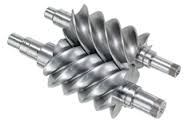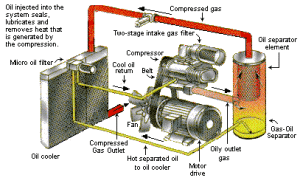Rotary Screw Compressor
A rotary screw compressor uses two meshing helical screws, known as rotors, to compress the gas. In an oil-flooded rotary screw compressor, lubricating oil bridges the space between the rotors, both providing a hydraulic seal and transferring mechanical energy between the driving and driven rotor.
Gas enters at the suction side and moves through the threads as the screws rotate. The meshing rotors force the gas through the compressor, and the gas exits at the end of the screws.
The effectiveness of this mechanism is dependent on precisely fitting clearances between the helical rotors, and between the rotors and the case for sealing of the compression cavities. Some leakage is however inevitable, and minimum rotational speeds must be used to minimize the ratio of leakage flow rate over effective flow rate. A rule of thumb is that the slower the RPM on a rotary screw compressor can assure the end user that the equipment is manufactured with tighter tolerances and will also experience less wear over the life of the compressor. Note: This is applicable for oil injected or flooded compressors only!
Rotary screw compressors tend to be compact and smooth running with limited vibration and thus do not require spring suspension. Many rotary screw compressors are, however, mounted using rubber vibration isolating mounts to absorb high-frequency vibrations, especially in rotary screw compressors that operate at high rotational speeds. Rotary screw compressors are produced in sizes that range from 10 cubic feet per minute to several thousand CFM. Rotary screw compressors are typically used in applications requiring more airflow than is produced by small reciprocating compressors but less than is produced by centrifugal compressors.
Oil Flooded, Oil Injected, or Lubricated Screw Compressor
In an oil-injected rotary screw compressor, oil is injected into the compression cavities to aid sealing and provide cooling sink for the gas charge. The oil is separated from the discharge stream, then cooled, filtered and recycled. The oil captures non-polar particulates from the incoming air, effectively reducing the particle loading of compressed air particulate filtration. It is usual for some entrained compressor oil to carry over into the compressed gas stream downstream of the compressor. In many applications, this is rectified by a coalescing/filter vessels or a high efficiency coalescing filter known as a mist eliminator.
Oil Free Screw Compressor
In an oil-free compressor, the air is compressed entirely through the action of the screws, without the assistance of an oil seal. To assist in the sealing areas a coating of some type is applied to the screws. In many oil free screw compressors that utilize a teflon coating there is a breakin period while the coated screws mesh to achieve the best possible seal. This coating which begins to wear upon startup is the normal failure point of an oil free screw compressor. It is also important to note that the efficiency of these compressors degrade over their lifetime (Typically 5 years) at which time the air end assembly that houses the screws must be replaced. They usually have lower maximum discharge pressure capability as a result. However, multi-stage oil-free compressors, where the air is compressed by several sets of screws, can achieve pressures of over 150 PSIG, and output volume of over 2000 cubic feet (56.634 cubic meters) per minute (measured at 60 °C and atmospheric pressure).
Oil-free compressors are used in applications where entrained oil carry-over is not acceptable, such as medical research, semiconductor manufacturing, high quality coating applications and instrument air. However, this does not preclude the need for filtration as hydrocarbons and other contaminants ingested from the ambient air must also be removed prior to the point-of-use. Subsequently, air treatment is still required although different from an oil injected compressor.


